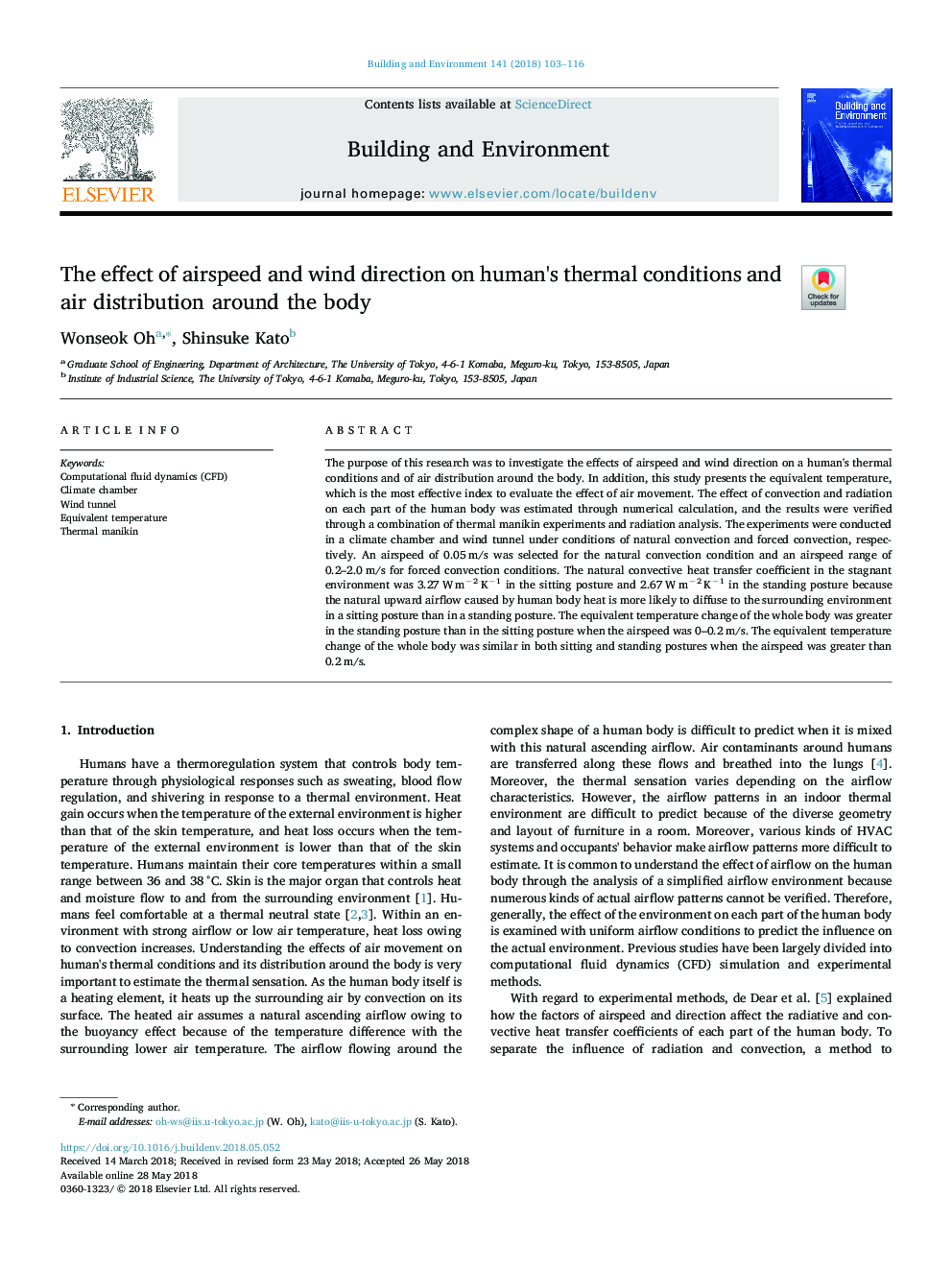| کد مقاله | کد نشریه | سال انتشار | مقاله انگلیسی | نسخه تمام متن |
|---|---|---|---|---|
| 6696928 | 1428351 | 2018 | 14 صفحه PDF | دانلود رایگان |
عنوان انگلیسی مقاله ISI
The effect of airspeed and wind direction on human's thermal conditions and air distribution around the body
ترجمه فارسی عنوان
تأثیر سرعت هوا و جهت باد روی شرایط گرمایی بدن و توزیع باد اطراف بدن انسان
همین الان دانلود کنید
دانلود مقاله ISI انگلیسی
رایگان برای ایرانیان
کلمات کلیدی
دینامیک سیالات محاسباتی (CFD)، محفظه آب و هوایی، تونل باد، دمای معادل، مانکن گرمایی
فهرست مطالب مقاله
چکیده
کلمات کلیدی
1-مقدمه
2- روش
1-2- روش عددی
2-2- روش آزمایش
3- نتایج
1-3- ضریب انتقال حرارت جابجایی
2-3- دمای معادل
4- محدودیتهای مطالعه
5- محاسبات
کلمات کلیدی
1-مقدمه
2- روش
1-2- روش عددی
2-2- روش آزمایش
3- نتایج
1-3- ضریب انتقال حرارت جابجایی
2-3- دمای معادل
4- محدودیتهای مطالعه
5- محاسبات
ترجمه چکیده
هدف این تحقیق بررسی اثر سرعت هوا و جهت باد روی شرایط گرمایی بدن انسان و توزیع هوا اطراف بدن است. به علاوه، در این مطالعه دمای معادل ارائه میشود که مؤثرترین شاخص برای ارزیابی تأثیر حرکت هوا است. اثر جابجایی و تشعشع روی هر قسمت از بدن از طریق محاسبه عددی تخمین زده شد، و نتایج از طریق ترکیبی از آزمایشهای گرمایی روی یک مانکن و تحلیل تشعشع بررسی شدند. آزمایشها در یک محفظه آب و هوایی و تونل باد تحت شرایط جابجایی طبیعی و جابجایی واداشته انجام شدند. سرعت هوای 0.05 m/s برای شرایط جابجایی طبیعی و دامنه سرعت هوای 0.2-2.0 m/s برای شرایط جابجایی واداشته انتخاب شد. ضریب انتقال حرارت جابجایی طبیعی در محیط ساکن در حالت نشسته برابر با 3.27 W m-2 K-1 بود و در حالت ایستاده برابر با 2.67 W m-2 K-1 بود زیرا احتمال پراکندگی جریان هوای رو به بالای طبیعی به وجود آمده به وسیله حرارت بدن در محیط اطراف در حالت نشسته نسبت به حالت ایستاده بیشتر است. هنگامی که سرعت هوا برابر با 0-0.2 m/s بود تغییر دمای معادل کل بدن در حالت ایستاده نسبت به حالت نشسته بیشتر بود. هنگامی که سرعت هوا بزرگتر از 0.2 m/s بود تغییر دمای معادل کل بدن در هر دو حالت نشسته و ایستاده مشابه بود.
موضوعات مرتبط
مهندسی و علوم پایه
مهندسی انرژی
انرژی های تجدید پذیر، توسعه پایدار و محیط زیست
چکیده انگلیسی
The purpose of this research was to investigate the effects of airspeed and wind direction on a human's thermal conditions and of air distribution around the body. In addition, this study presents the equivalent temperature, which is the most effective index to evaluate the effect of air movement. The effect of convection and radiation on each part of the human body was estimated through numerical calculation, and the results were verified through a combination of thermal manikin experiments and radiation analysis. The experiments were conducted in a climate chamber and wind tunnel under conditions of natural convection and forced convection, respectively. An airspeed of 0.05â¯m/s was selected for the natural convection condition and an airspeed range of 0.2-2.0â¯m/s for forced convection conditions. The natural convective heat transfer coefficient in the stagnant environment was 3.27â¯Wâ¯mâ2â¯Kâ1 in the sitting posture and 2.67â¯Wâ¯mâ2â¯Kâ1 in the standing posture because the natural upward airflow caused by human body heat is more likely to diffuse to the surrounding environment in a sitting posture than in a standing posture. The equivalent temperature change of the whole body was greater in the standing posture than in the sitting posture when the airspeed was 0-0.2â¯m/s. The equivalent temperature change of the whole body was similar in both sitting and standing postures when the airspeed was greater than 0.2â¯m/s.
ناشر
Database: Elsevier - ScienceDirect (ساینس دایرکت)
Journal: Building and Environment - Volume 141, 15 August 2018, Pages 103-116
Journal: Building and Environment - Volume 141, 15 August 2018, Pages 103-116
نویسندگان
Wonseok Oh, Shinsuke Kato,
